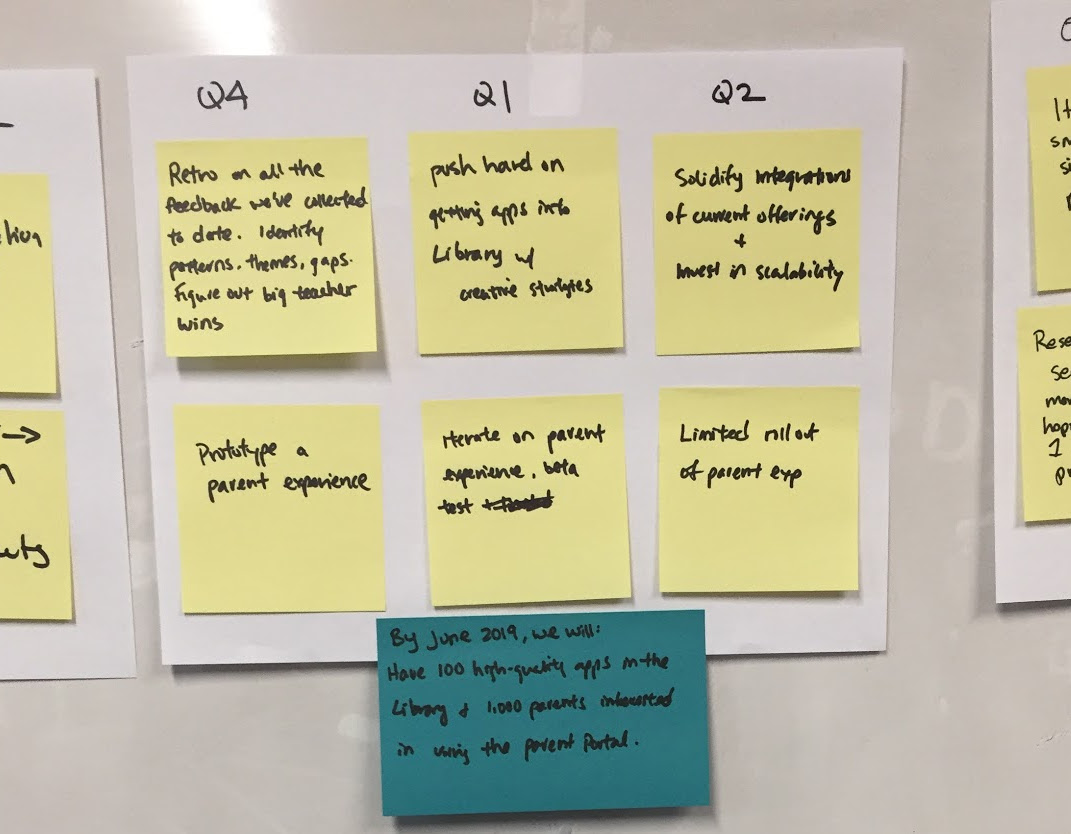3x2x1 - An artifact for engaging teams in long-term planning
As products mature, I like to start “layering” goals and objectives so that our efforts this quarter help us achieve our annual plan, which in turn will get us closer to our 3-5 year vision. To build these long-term plans with my team, I first start by getting everyone on the team to create an artifact I call the “3x2x1” that promotes long-term thinking, forces tradeoffs, and helps people persuasively express the direction they think the team should take.
A "3x2x1" is a way to generate and communicate a long-term plan with:
- 3 columns, each corresponding to a period of time (e.g. a quarter)
- 2 big themes per period
- 1 capstone statement that summarizes what you'll have achieved when the plan is completed
Here's an example of one of my teammate's 3x2x1 from last year's annual planning:

While you can make one of these on your own to structure your thoughts, the making of 3x2x1's really shines as an exercise done with a team. I’d recommend scheduling a full day or half-day offsite to build these, but I’ve done this exercise in as little as a 1-hour meeting. Here’s the process I follow:
- First, run a few exercises to prime people with context and get their thoughts flowing. Exercises might include reading your team or company’s mission statement, having a founder talk about why they started the company and what they see as the company’s mandate, or having members of the team prepare and share possible “Day in the Life” stories about your customers in the future. The goal is to get people thinking big and long-term - if you have time, run a brainstorming session after priming people to get lots of big ideas into the collective conscience.
- Give each person a normal, 8.5x11 sheet of paper, a set of six square sticky notes, and one bigger rectangular sticky note. People label three columns on their paper - for annual planning, one for each of the next three quarters[1].
- Quietly and on their own, each person gets to write down two big meaty themes in each column for the headline initiatives that you’d focus on for the quarter and rally the team around. People can pull from the big ideas brainstormed earlier or come up with new ones. Encourage people to think about sequencing and how efforts in one column might enable or flow into subsequent initiatives. Narrowing down to just two per column will be hard - this is intentional!
- Each person then caps off their set of initiatives with a single, capstone summary of what these initiatives will add up to: on the bigger rectangular sticky note, each person completes the sentence “By [date], we will…”
These artifacts now serve as concise articulations of each person’s vision of where your team could be and how to get there. Have each person walk through their 3x2x1 with the team, and then run a dot-voting exercise for members of the team to amplify the ideas they feel are most important. With these artifacts in hand, you’re now ready to create a unified strategy that borrows from the best ideas of your team.
Through the process of creating these 3x2x1’s, your teammates get an opportunity to think of big ideas, weigh difficult tradeoffs between competing demands, and figure out how to weave a coherent strategy. This process generates compelling ideas, but importantly also creates empathy amongst your team around the variety of possible directions and the necessity to make tradeoffs. As a result, they are much more likely to be on board with the resultant unified strategy, even if their specific ideas aren’t incorporated in it.
In the description above, I used the example of creating an annual plan, but you can use the same exercise to create a three-year plan or any other time period by substituting the columns with different intervals. I found three columns to be the “sweet spot,” but you could do four or even five if necessary. I would not recommend adding more than two rows of sticky notes per column, however, as the constraints help people distill and prioritize. In the actual, unified plan you can have more than two big themes for the quarter/year, but I wouldn’t recommend it for the exercise.
As a final note: at a recent planning, a colleague of mine tried an addition where they had people write one additional sticky note for the year which is what they personally were most excited about for the year. This could be a skill they want to develop, a theme or mission they find inspiring, or a part of the strategy they want to be heavily involved in. These are the people that are going to be executing on the plan, so it’s helpful to know not just what they think the team should do but also what motivates them individually.
Notes
[1]: At Clever during Q3 we typically focus on surviving the Back to School rush, so our big initiatives are usually slotted in Q4, Q1, or Q2. For a less seasonal business, you could adapt this into a “4x2x1” model.